
Weathered Ground lands its Fonta Flora collaboration saison
September 8, 2019
Almost a year and a half in the making, but the wait was worth it. Lay of the Land Saison from Weathered Ground Brewery hits all the right notes.
When Weathered Ground got together with Fonta Flora Brewery, one of America’s hottest small breweries, to brew a beer in West Virginia, we hoped for something magic. The resulting medium-bodied, mildly-funky brett saison is a beauty and comparable to some of the nation’s best farmhouse ales.

It was surprising to hear the usually very modest Sam Fonda, Weathered Ground’s head brewer/co-owner, comment on it so forthrightly.
“I’m super proud of this beer,” he said. “I think it’s one of the best beers I’ve ever made. Even though we will never have chalkboards full of them, I will always be head-strong about brewing saisons.”
Fonda loves the beer’s balance and complexity. He says the grains, the hops, the yeast, the barrel, the cider, the peaches, the maple syrup are all there, “but none of it punches you in the face.”
A two state mash up
The highly acclaimed Fonta Flora Brewery, of Morganton, North Carolina, is revered for its innovative, wild and funky farmhouse ales that often feature local ingredients. Weathered Ground, in it’s first two years in business, has already distinguished itself as one of West Virginia’s most creative breweries. This collaboration saison, which the two breweries concocted at Weathered Ground, is a real mash-up of West Virginia and North Carolina influences.
To put this baby in the tank, Fonta Flora’s head brewer, Todd Boera arrived in Cool Ridge, WV one spring morning in 2018. He met up with Weathered Grounds’ brewing team of Sam Fonda, Jr. and Anthony Meador. A few years back, Sam and Todd had become acquainted while Sam was working for Triple C Brewing Company in Charlotte. Over the years, Fonda and Boera got to talking about the possibilities of doing a brew together. On April 24, 2018, that talked-about brew day began.
North Carolina grains

At Weathered Ground’s brewhouse, they mashed in a mixture of North Carolina grains, which included malted buckwheat from Epiphany Craft Malt in Durham and Southern Select Barley and Seashore Rye malts from Riverbend Malt House in Asheville. Adding buckwheat and rye malts to regular brewer’s malt is typically done to produce more complexity or additional layers of flavor in the finished beer. Buckwheat can add a slightly nutty flavor and rye is known for its slightly spicy flavor and for adding a silkiness to the beer’s body.
In a typical farmhouse brewer response, Fonda says the grain bill was largely selected because it was what he had on hand the day they brewed. Don’t let the casual response fool you, the blend and proportion of grains used comes from years of brewing experience between Boera and Fonda.
Secret West Virginia ingredient
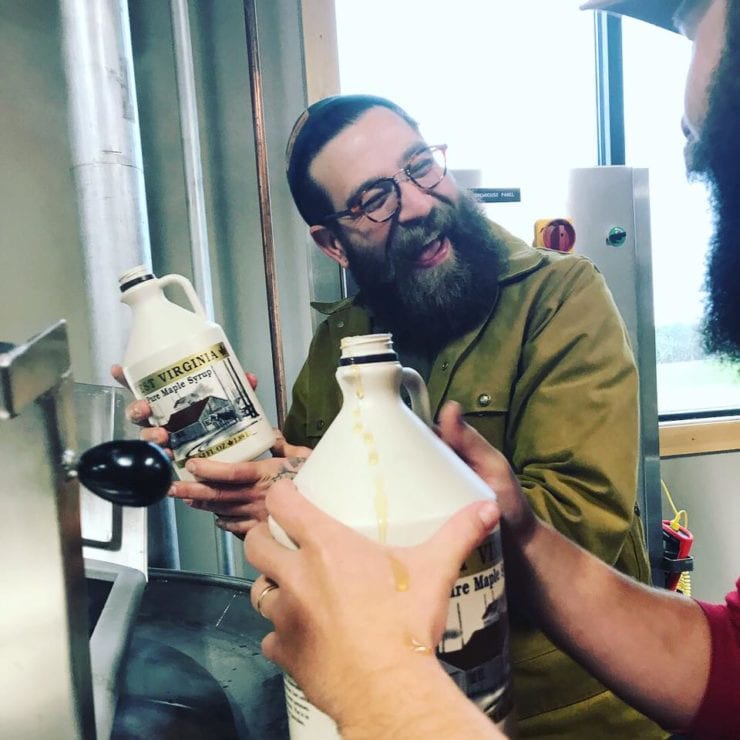
After an hour or so with mashing completed, the sweet wort drained from the mash tun into the boil kettle. Now it was time for the secret West Virginia ingredient. That ingredients was 50 pounds of pure maple syrup from Moonstruck Maple of Brooks, WV in nearby Summers County. The maple syrup would add a touch of that luscious woody, toasted-sugar flavor to the resulting brew.
While hops were not meant to play a leading role in this beer, Fonda and Boera decided to add a little Centennial early in the boil for bittering and then some Czech Kazbek hop towards the end to give it a little extra floral, earthy spice of the Noble hop.
Following the boil, the wort was pumped into the fermentor where it was inoculated with a pitch of French Saison yeast, along with some Brettanomyces Bruxellensis. This particular saison yeast is noted for creating farmhouse-style beers with a cleaner aroma profile. The Brett works more slowly and adds a little fruity-spicy-funkiness and will also eat more of the sugars and tend to dry out the beer if given the time.
Barrel-aging for flavor development

After the primary fermentation was completed in the stainless steel tank, the beer was pumped into four wooden barrels. Those barrels have a heritage about as straight as a crooked mountain road. They started their life about 11 or 12 years ago as new, freshly charred oak barrels holding bourbon produced at the MPG distillery in Lawrenceville, Indiana. Those barrels were part of a lot later purchased by Smooth Ambler Spirits of Maxwelton, WV. Smooth Ambler further aged the product, then blended and bottled it as one of their Old Scout Bourbons. Next, those empty barrels traveled a few miles south to Hawk Knob Cidery in Lewisburg, where they were filled with West Virginia apple cider, aged for six months or so, then emptied again. Finally, the barrels were sold to Weathered Ground Brewery in 2017 and filled with a Saison that became WGB’s Rad Roots. Once emptied again, the barrels were refilled in May 2018 with the new WBB-FFB collaboration saison.
Over the first summer in the barrel, while the brett was just beginning to do its thing, the beer picked up a character that Sam Fonda describes as “very much cider forward a lot like our Rad Roots, but this beer has way more body and the maple syrup was there too.”
West Virginia peaches, in the hole
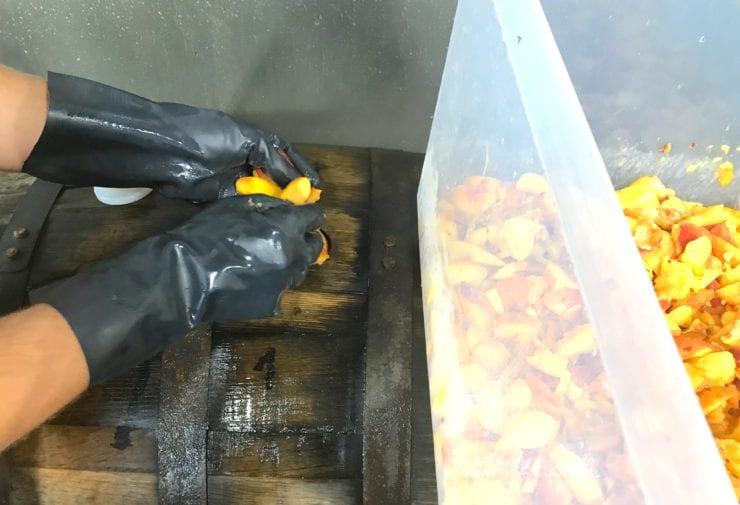
Then on September 1, 2018, Fonda added 100 lbs. of fresh West Virginia peaches to the beer, roughly 25 lbs per barrel. Since the peaches were fresh and not pasteurized, they also introduced a mix of native wild yeasts and bacteria to the beer. The addition of the fruit sugars in the peaches caused a vigorous new fermentation to kick off, which finished within a week.
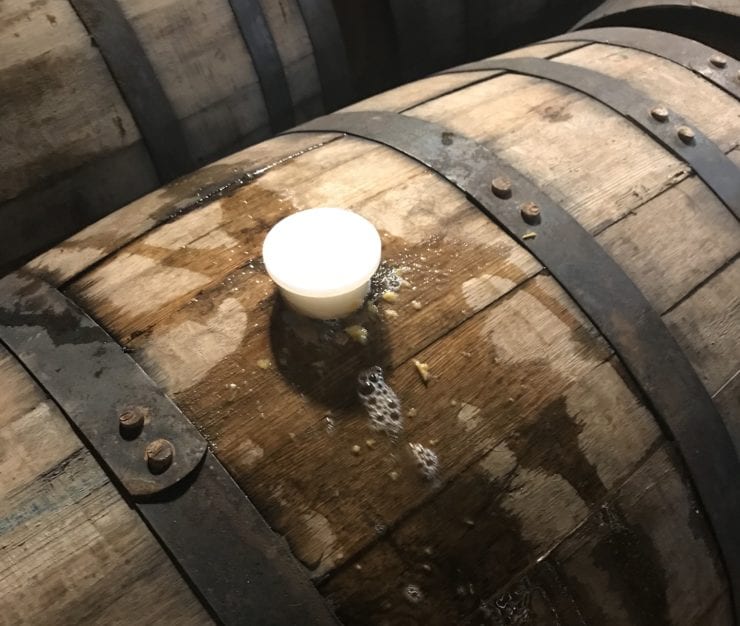
At the end of this fermentation, the barrels were rebunged and rested in the brewery at room temperature. From that point on, as the brett was doing its thing, Fonda monitored the beer closely, tasting it regularly to determine when it would be ready to package and sell.
Then late last spring, Fonda saw the beer was reaching its peak. It had been in the barrels for almost a year, and they had worked their magic on it. The stronger apple cider flavors that were present in its youth had diminished, as had most of the assertive maple syrup flavor. What was left was a dry, lighter, complex, slightly funky-earthy-fruity brew with just hints of apple and spice.
“It was a very fun process,” Sam said. “I consider myself impatient, but with this beer, I wanted to make sure it sat a long time and got to fully mature.”
Bottle conditioning with a twist
Fonda decided he would bottle condition the beer in the manner of traditional saisons. That meant he would add some fresh sugar and yeast to the beer just before filling the bottles and capping them. This sets up a new, small fermentation inside the bottle that produces the carbon dioxide which then naturally carbonates the beer.
Here is where Fonda decided to give the beer one final twist. Why not? Instead of using the normal cane sugar or corn sugar to prime the bottles, he instead used more Moonstruck maple syrup. Not knowing the exact sugar content of the maple syrup, his priming addition was a bit of a guess. For the yeast, he opted to use a Belgian ale yeast strain.
From the four barrels, they got about 150 gallons of beer. Bottling took place in late May. Total yield was 540 half-liter bottles and a few one-sixth barrel kegs filled for taproom sales.
With the Belgian yeast liking warmer temperatures to finish fermenting, the bottles were left in the brewery, where the garage door was open in the daytime allowing it to warm from the outdoor June air.
A week or so after bottling, they began opening a bottle twice a week to check on its progress. Bottle conditioning was given a full month to complete its work before Fonda deemed the beer ready. The four weeks of conditioning ensured that the priming sugar (the maple syrup) was fully consumed and the beer had the high carbonation level that Fonda desired. The beer was moved to the cold room to rest a while. Fonda then the bottle release date for August 28.
Store the beer chilled
One caveat Fonda notes is that, because this beer is highly carbonated and alive in the bottle, the beer needs to be kept chilled until after it is opened. Once the beer is opened, it can then be poured into the glass and allowed to warm up to a proper drinking temperature of around 45 degrees F. Like any delicate white wine or Belgian saison, the beer does not show as well at cold refrigerator temperature, which dulls the flavor. Let it warm up a bit in your glass before drinking it, and you will be rewarded with a much enhanced experience. The rule for this kind of beer is chilled not cold.
“One of my favorite things to do when I buy a beer like this is to read the label and try to taste all the listed ingredients,” Sam says. “Some people pick up things better than others.”
Label designed by WV native
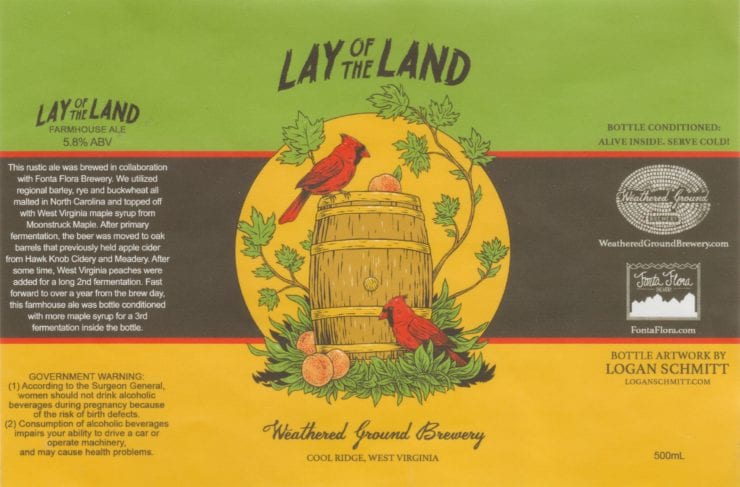
The origin of the label design is an interesting story. Sam says that illustrator Logan Schmidt, who is a Wheeling, WV native, reached out to him before the brewery was even open and pitched the idea of doing a label for the brewery. Schmidt is an accomplished artist who produces posters for big-name bands like Old Crow Medicine Show, The Avett Brothers, and Van Morrison. Schmidt has also done beer labels for breweries in Ohio, Pennsylvania, and Virginia. Fonda loved Schmidt’s style and filed away Schmidt’s name in the back of his mind. When it became time to get this beer ready for bottling, the link was made.
“He was a name that popped into our heads when we were talking about bottling this beer,” Sam said. He thought Schmidt’s nature-themed art style was perfect for what Lay of the Land Saison represented. “It’s a really important beer to us, and we needed to do something really cool.”
The label shows the wooden barrel, peaches, and maple leaves that are connected to the beer. The two cardinals represent the collaboration; they are official state birds of both North Carolina and West Virginia.
Fonda says the name Lay of the Land grew out of his reason for the collaboration. It was his goal, in this collaboration with Boera, that he might learn the lay of the land for making an excellent saison. He said he had not been completely happy with his previous Weathered Ground saison brewing efforts and longed to make a completely satisfying beer in the style. In this collaboration, he wanted to learn from the master Boera. Fonda said the name summed up the beer well.
He says Lay of the Land is also illustrative of the beer’s ingredients from the lands of West Virginia and North Carolina. “I thought it was a cool theme for our first farmhouse collaboration.”
Get Lay of the Land Saison while it lasts
This kind of rare collaboration beer is so unusual to see from a West Virginia brewery. With only about 500 bottles of Lay of the Land Saison to go around, it will not last long. A handful of West Virginia’s top craft beer accounts are getting the beer, while the rest will be sold at the brewery taproom. Should retail around $8 to $10. ABV 5.8%
This saison-style beer is definitely a food-pairing beer. It is one of those beverages that, when enjoyed with a meal, shows even more charm than it would by itself. It has a lot of affinity with a white wine, maybe something like an American oak-aged chardonnay. Taste it with someone who enjoys white wine but doesn’t think they like beer. This one might change their mind.
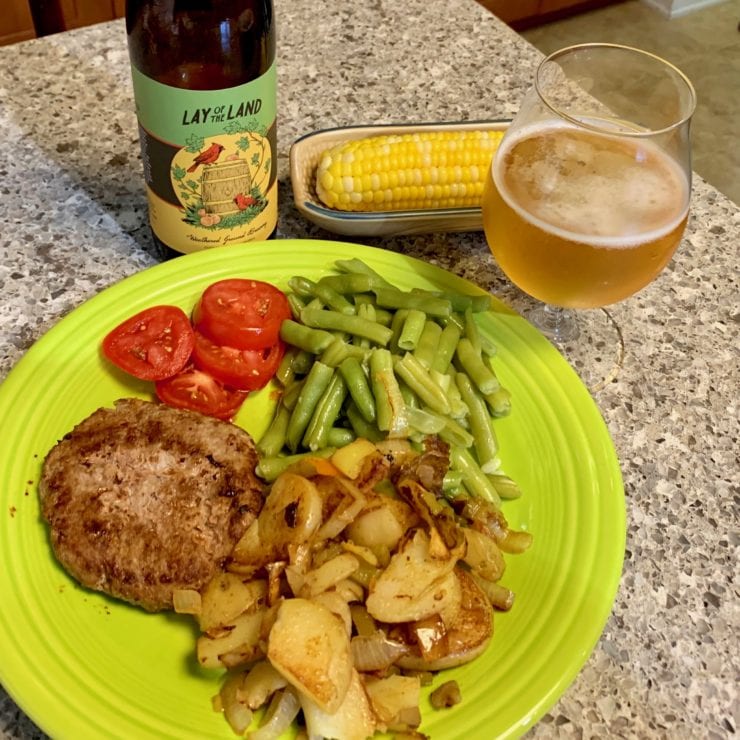
Almost every day, Fonta Flora and Weathered Ground are expanding the brewing envelope in the mountain regions of North Carolina and West Virginia, respectively. We are living in an extremely rich time for local beer. We truly hope this is not the only time these two hard-working Appalachian breweries get together to share their brewer’s art. Brilliant Stream named Weathered Ground it’s West Virginia Brewery of the Year for 2018.

